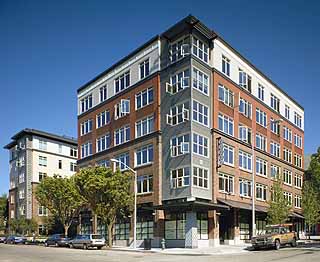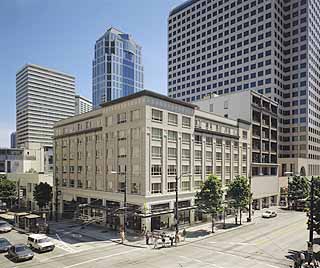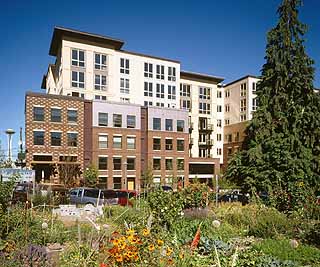
DJC.COM
October 7, 2004
The three C's of urban infill
GGLO
As our Seattle built environment densifies, urban infill projects revitalize our neighborhoods and cities as they literally repair themselves to become dynamic communities.
Whether a small but strategic site in a Seattle neighborhood or the grand scale transformation taking place at Ground Zero in New York, urban infill projects can create a metamorphosis in the character, function and social condition of our city.
The political, economic, demographic and development climate has been ripe for urban infill. In Seattle, the combined pressures of growth boundaries, population growth and the delayed progress on public transit are creating an environment of increasing density and infill housing opportunities as a new lifestyle of urban dwellers is born.
By nature, urban infill projects are challenging because they deal with a usually complicated existing context, the needs of a community, and the hot buttons of market demands. Should the infill project be a "background" building and blend in, or a "foreground" building and stand out? Will the structure elaborate on existing neighborhood character or set the tone for a new identity and civic presence?
Recent approaches for different developers in three distinctive Seattle neighborhoods offer case studies in urban infill solutions, addressing issues of appropriate density, response to community desires, and contextual identity at Press, The Gilmore and Alcyone.
Press

Photo by Eduardo Calderon
URBAN INFILL CASE STUDY NO. 1: Press
Developed by Harbor/Heath LLC, Press reflects the “rail and rung” intersection of commercial and residential influences with a colorful, animated commercial face and a comfortable residential courtyard. |
At what was eventually to be known simply as Press, a 75-unit apartment building on lower Pine Street on Capitol Hill, it all started with doing our community homework: a half-day visioning session with community leaders, retail tenants, and family land owner and developer representatives to kick off our research and context phase for the infill project.
What evolved from our discussions was the image of an eclectic, industrious and artistic community given to lots of interaction and impromptu gatherings, a residential neighborhood co-existing with commercial businesses and reflecting the history of the printing press roots of the site and its owners, the Heath Brothers.
So for Press, we envisioned a solid "background" building that would create its own community, while relating to the owner's adjacent printing business and the neighborhood's "rail and rung" street grid character and auto row heritage.
To echo the intersection of commercial and residential uses on the site with two Seattle code zones, we designed a building with two stories to tell — a grittier commercial front on Pine Street and the comfortable residential courtyard building on Belmont Street.
The commercial character on the "rail" is animated and colorful, featuring glass tile wall and corner focal column with roll up garage door storefronts and a masonry and metal façade. Turning the corner to the "rung" reveals a classic Capitol Hill green residential entry courtyard with fountain. The adjacent community room welcomes pedestrians and serves as the family room for Press and residential Belmont Street.
Interiors of the community room and the residences use a mix of concrete floors, biocomposite countertops and rolling chalkboard wall dividers. The printing history of the site is literally integrated into the walls, floors and spaces through an interpretive story presented through recycled lead letters imbedded in the concrete floors, printing press sculpture and interpretive artwork.
Press ultimately has created more than just a good neighbor. It has become a role model for future infill development by the local community and design review board, a testament to its positive contribution to the Capitol Hill neighborhood.
The Gilmore

Photo by Eduardo Calderon
URBAN INFILL CASE STUDY NO. 2: The Gilmore
The result of a partnership between Housing Resources Group and AF Evans Co., the Gilmore creates affordable, workforce housing in the heart of the downtown retail core. |
The first new affordable housing to be built in Seattle's downtown retail core in the last 50 years, the Gilmore contains five residential floors with 65 apartments. Rising above retail and commercial space and a Metro tunnel access, this workforce housing serves people who otherwise might not have easy access to jobs or transportation.
Conceived through the partnership of a nonprofit housing developer and a for-profit commercial developer, we designed the Gilmore to respond to a diverse program and context of affordable, residential comfort above street level commercial space on an intense downtown intersection.
Common cause between government initiative, social mission and market revenue goals responded to the need to reclaim this urban corner with a history of deferred maintenance, panhandling and drug activity.
The Gilmore's exterior character and finishes complement the historic context of the neighborhood. Tested in a challenging public design review process, the building's pier and spandrel elevation recalls the character of adjacent office and commercial structures. Its ceramic tile finish at street level resists abuse, while echoing the terra cotta cladding of its early 20th century neighbors.
Residents enjoy a landscaped courtyard, street level lobby, laundry and recycling facilities. The building, a participant in Seattle City Light's "Built Smart" program, uses energy-conserving insulation, glazing and lighting that exceed code requirements and should result in cost savings for tenants.
The Gilmore has been lauded for its smooth "always been here" contextual fit, its contribution to affordable downtown housing and its successful transformation of that troubled urban corner.
Alcyone

Photo by Steve Keating
URBAN INFILL CASE STUDY NO. 3: The Alcyone
Developed by Vulcan Inc. in partnership with Harbor Properties, Alcyone sets the tone for high-density, market rate housing within the Cascade Neighborhood, part of the flourishing South Lake Union region. |
Located in the Cascade Neighborhood across from Cascade Playground, our design of 162-unit Alcyone was shaped by several significant neighborhood and developer goals for quality, art, livability and sustainability.
Alcyone's story is of a "foreground" building, creating a new housing paradigm for an existing neighborhood, fitting the current context, but breaking new ground in realizing what the neighborhood can achieve in the future.
After numerous neighborhood meetings, the primary community concerns included activating the alley, retaining a view of the Space Needle from Cascade Park across the street, ensuring that critical sunlight continued to reach the community's P-patch, incorporating sustainable design features into the site and building, and creating active, pedestrian-friendly residential streetscapes.
Extensive shade and shadow studies resulted in increased upper level setbacks along Thomas Street to preserve sunlight for the P-patch, as well as views of the Space Needle.
An increased street level setback along Minor Avenue allows a wide sidewalk with landscaped frontage to complement the character of Thomas, a city green street. To activate the streetscapes, residential flats, townhouses, lofts or work-live units open their front doors onto all three streets.
Alcyone's mass, dual lobbies and exterior materials were designed to suggest two separate quarterblock developments, with each elevation reflecting a distinctive use and character.
Art is also used to evoke and define community connections. Local artist, Deborah Mersky, created large metalwork screens to frame ventilation openings in garage walls and smaller metalwork details that enclose light fixtures at the retail and main lobby spaces.
The brick-and-metal townhouse character of the Minor Avenue elevation relates to traditional urban neighborhoods you might find in Boston or Chicago. The Thomas Street elevation has flush commercial storefronts and concrete-framed work-live units, while alley work-live units are more industrial and mix concrete and steel with roll-up, glazed garage doors.
Alcyone is registered for LEED certification.
The building's design focused on occupant health and comfort through use of low VOC interior finishes, ample daylight and views, and improved ventilation. Amenities include a rooftop P-patch with captured rainwater irrigation. Above the concrete base, the building was constructed with 66 percent recycled-content light-gauge steel framing to increase durability and eliminate shrinkage.
Each of these distinctly different urban infill projects resulted in residential multifamily housing that has been embraced by tenants and praised by the local community.
Press and The Gilmore represent successful design review projects and will be displayed at the city's upcoming 10 Year Design Review Anniversary celebration. Alcyone went through an extensive neighborhood review process and is enjoying public and development community praise for its fit in a dynamically growing neighborhood.
If the mantra for successful real estate is location, location, location, the key to effective urban infill is context, communication and connection. Design for the existing context, communicate with the surrounding community often and connect with the market, and your project will be both a good investment and a good neighbor.
Bill Gaylord AIA, LEED AP, is a founding principal of GGLO.
Other Stories:
- Tough Seattle neighborhood reinvents itself
- Here's how to get out of your car
- Let's learn about 'smart growth' — quickly
- SEED plants a legacy in Rainier Valley
- Workers get homes, with help from their bosses
- Living in a cubby hole? Make it look big
- Mixed feelings about mixed-use
- Transportation overhaul for South Lake Union
- Office space: Are we finally shrinking?
- Downtown housing has a bright future in Seattle
- A road map for cities in transition
- Where's the family in multifamily?
- Creative builders take on changing land rules
- Is Seattle ready for urban greensheds?
Copyright ©2009 Seattle Daily Journal and DJC.COM.
Comments? Questions? Contact us.